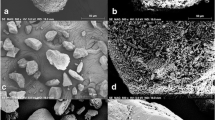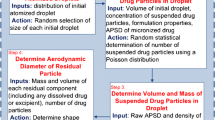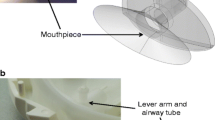Abstract
Purpose
To determine a relationship between adhesive and cohesive inter-particulate forces of interactions and in vitro performance in pressurised metered dose inhalers (pMDIs) suspension formulations.
Methods
Interparticulate forces of salbutamol sulphate (SS), budesonide (BUD) and formoterol fumarate dihydrate (FFD) were investigated by in situ atomic force microscopy (AFM) in a model propellant 2H, 3H perfluoropentane (HPFP). Experimental data were analysed using the recently developed cohesive/adhesive analysis method (CAB) and compared with in vitro deposition performances in pMDIs systems using Andersen cascade impactor (ACI).
Results
The in vitro investigation suggested that the micronised drug materials had significantly different aerosolisation profiles when manufactured as single or combination formulations. In general, the greatest significant differences were observed between SS single drug and SS-BUD and SS-FFD combinations. Analysis of the in vitro performance for the SS only formulation suggested that the cohesive nature of SS (as predicted by the CAB and observed with AFM) led to tightly bound flocs that did not fully deaggregate upon aerosolisation.
Conclusions
It is suggested that the relationship between interparticulate interactions and in vitro performance of pMDIs suspension systems, when compared to direct measurement of the adhesion/cohesion forces, indicated good correlation. This approach may be useful in expediting the development of pMDI formulation and predicting performance.













Similar content being viewed by others
References
P. J. Barnes, M. M. Grunstein, A. R. Leff, and A. J. Woolcock. Asthma, Lippincott-Raven, Philadelphia, 1997.
R. N. Dalby and J. Suman. Inhalation therapy: technological milestones in asthma treatment. Adv. Drug Deliv. Rev. 55:779–791 (2003).
H. D. C. Smyth. Propellant-driven metered-dose inhalers for pulmonary drug delivery. Expert Opin. Drug Deliv. 2:53–74 (2005).
A. Brindley. The chlorofluorocarbon to hydrofluoroalkane transition: the effect on pressurised metered dose inhaler suspension stability. J. Allergy Clin. Immunol. 104:S221–S226 (1999).
D. Traini, P. Rogueda, P. M. Young, and R. Price. Surface energy and interparticle forces correlations in model pMDI formulations. Pharm. Res. 22:816–825 (2005).
R. J. Good and L. A. Girifalco. A theory for estimation of surface and interfacial energies. III. Estimation of surface energies of solids from contact angle data. J. Phys. Chem. 64:561–565 (1960).
F. M. Fowkes. Determination of interfacial tension, contact angles and dispersion forces in surface by assuming additivity of intermolecular interactions in surfaces. J. Phys. Chem. 66:382 (1962).
C. J. van Oss. Interfacial Forces in Aqueous Media. Marcel Dekker, New York, U.S.A., 1994.
P. Begat, D. A. V. Morton, J. N. Staniforth, and R. Price. The cohesive–adhesive balances in dry powder inhaler formulations I: direct quantification by atomic force microscopy. Pharm. Res. 21:1591–1597 (2004).
Apparatus D, British Pharmacopoeia. The Stationery Office on behalf of the Medicines and Healthcare Products Regulatory Agency (MHRA). London, UK, 2005.
N. J. C. Snell and D. Ganderton. Assessing lung deposition of inhaled medications: consensus statement from a workshop of the British Association for Lung Research. Respir. Med. 93:123–133 (1999).
C. G. Thiel. Can in vitro particle size measurements be used to predict pulmonary deposition of aerosol from inhalers? J. Aerosol Med. 11:S43–S52 (1998).
P. A. Webb and C. Orr. Analytical Methods in Fine Particle Technology, Micrometrics Instrument Corp., Norcross, Georgia, U.S.A., 1997.
G. Rhodes. Crystallography—Made Crystal Clear, Academic, New York, USA, 1993.
J. Albertsson, A. Oskarsson, and C. Svensson. X-ray study of budesonide: molecular structure and solid solution of the (22S) and (22R) epimers of 11B,21-dihydroxy-16alfa,17 alfa-propylmethylenedioxy-1,4-pregnadiene-3,20-dione. Acta Crystallogr. B34:3027–3036 (1978).
Ertan, B. Stensland, and I. Ymen. Crystal and molecular structure of formoterol fumarate dihydrate, Astra Production Chemicals AB, Confidential Report N. 117/97, 1997.
P. J. M. Leger, M. Goursolle, and M. Gadret. Structure cristalline du sulphate de salbutamol [ter-butylamino-2-(hydroxy-4hydroxymethyl-3 phenyl)-1 ethanol.1/2 H2SO4]. Acta Crystallogr. B34:1203–1208 (1978).
W. A. Ducker, T. J. Senden, and R. M. Pashley. Direct measurement of colloidal forces using an atomic force microscope. Nature 353:239–241 (1991).
P. M. Young. Characterisation of particle–particle interactions using the atomic force microscope, Pharmacy and Pharmacology, University of Bath, Bath, UK, 2002.
Y. Michael, M. J. Snowden, B. Z. Chowdhry, I. C. Ashurst, C. J. Davies-Cutting, and T. Ripley. Characterisation of the aggregation behaviour in a salmeterol and fluticasone propionate inhalation aerosol system. Int. J. Pharm. 221:165–174 (2001).
E. M. Phillips, P. R. Byron, and R. N. Dalby. Axial-ratio measurements for early detection of crystal-growth in suspension-type metered dose inhalers. Pharm. Res. 10:454–456 (1993).
P. G. A. Rogueda. HPFP, a model propellant for pMDIs. Drug Dev. Ind. Pharm. 29:39–49 (2003).
J. N. Pritchard. The influence of lung deposition on clinical response. J. Aerosol Med. 14:S19–S26 (2001).
W. Neumann, D. R. Renzow, H. Reumuth, and J. E. Richter. Vol. 55, Fortschr. Kolloide Polymere 49–54 (1971)
G. Buckton. Interfacial Phenomena in Drug Delivery and Targeting, Harwood Academic Publishers, Chur, Switzerland, 1995.
Author information
Authors and Affiliations
Corresponding author
Rights and permissions
About this article
Cite this article
Traini, D., Young, P.M., Rogueda, P. et al. In Vitro Investigation of Drug Particulates Interactions and Aerosol Performance of Pressurised Metered Dose Inhalers. Pharm Res 24, 125–135 (2007). https://doi.org/10.1007/s11095-006-9130-2
Received:
Accepted:
Published:
Issue Date:
DOI: https://doi.org/10.1007/s11095-006-9130-2




